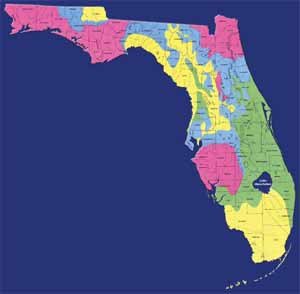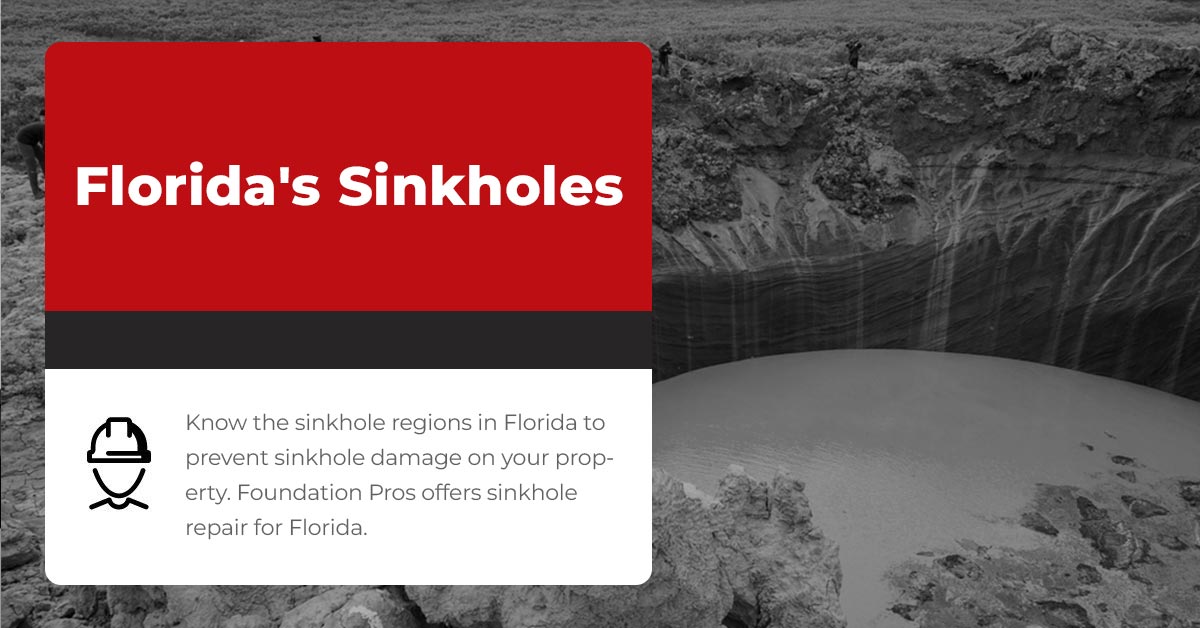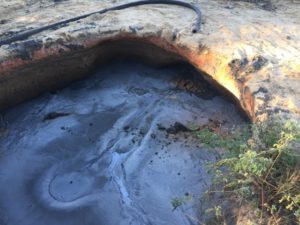Mapping Florida’s Sinkholes: Understanding the Sinkhole Threat

The regional map on the right depicts sinkhole locations that have been reported since 1954 by the Florida Geological Survey Series No. 110. It does not show all sinkhole activity in Florida, but you can get a generalization of how widespread this problem is.
Sinkhole Zones in Florida
- Zone 1 (Yellow): This region consists of exposed or thinly-covered carbonate rocks. Broad and shallow sinkholes are common in this area. Cities in the zone 1 region include Miami, Coral Springs, Hialeah, and Hollywood.
- Zone 2 (Green): This region has permeable sand that varies in thickness from 20 to 200 feet. It mainly consists of small cover subsidence. Zone 2 cities include Fort Lauderdale, Port St. Lucie, and Orlando.
- Zone 3 (Blue): Zone 3 has cohesive, low-permeable soil that forms abrupt collapse sinkholes. Cities in zone 3 include Tampa, Tallahassee, and St. Petersburg.
- Zone 4 (Pink): This region consists of deeply inter-bedded carbonate rocks and cohesive clayey sands. Sinkholes are uncommon in this region, but collapse and small subsidence sinkholes can occur in shallow beds. Cities located in zone 4 include Jacksonville and St. Augustine.
Sinkhole formation has accelerated over the years. They are commonly created by extended droughts, heavy rainfall, land development, water pumping, and construction of retention ponds. Sinkholes in Florida can range in size small to large. Some are large enough to swallow homes, roads, swimming pools, and buildings.
Not only does sinkhole activity destroy structures, but they also pose an environmental concern. The carbonate rocks, which are present in sinkhole formation, provide direct access to all types of pollutants such as fertilizers and pesticides. Oil and gasoline also channel directly into the sinkhole. Despite all the problems sinkholes produce, they are a natural part of the ecosystem.
Know the Common Signs of Sinkholes in Florida
As a homeowner or business owner, it is important to know the common signs of sinkholes in Florida. Most sinkholes give early warning signs before they create become a serious threat. Look for the common signs of sinkhole activity such as:
- Cracks in interior joint areas
Cracks in stucco or exterior block
- Sticking windows and doors
- Yard or street depressions
- Separations, cracks, and gaps in concrete
- Wilting plants
- Neighbors with sinkholes
- Actual cavity forming
- Foundation cracks
- Settling foundation
- Sloping floors
- Ceiling cracks
- Loss of pool water
If you notice any of these signs, give us a call. We can inspect your issue to see if it is a sinkhole and repair it if necessary. We offer sinkhole repair for the residents of Florida. Our services include compaction grouting and void filling.
- Compaction grouting: This is designed to stabilize loose soil. It is a fast settling method that uses polyurethane foam that is injected into loose soil. As the foam expands, it compacts the soil.
- Void filling: This is another sinkhole repair method. It involves filling up spaces and gaps underneath the concrete. We use a high density, lightweight material called polyurethane. It is injected into drilled holes. It expands as a foam, covering the area in seconds.
Foundation Professionals of Florida has the skills and experience for all of sinkhole repair needs. Our technique will support and stabilize the soil on your property to give you extra protection against sinkhole activity in Florida. Contact us today if you need an estimate.


 Cracks in stucco or exterior block
Cracks in stucco or exterior block
Hello Mr. Brown, I have been living in FL almost all my life as I was born in Illinois but we moved to sunny FL vs Chicago where I was born. I have lived from the FL keys to Miami Dade, Broward, and West Palm Beach. I recently found out about the sink hole problem in FL which was something I never knew until lately when I started to look for an area to move to but it looks like sink holes can happen anywhere in FL so it has me concerned because now I don’t know where I can move to and it is worrisome to know that houses have been swallowed by the earth. In your professional opinion, where is the least probability to encounter sink holes in FL?
I have a friend that would like to move to the Villages or Ocala area is this safe from sinkholes she’s been getting very bad responses from real estate people down there any help would be great especially in areas that are less prone kissing calls